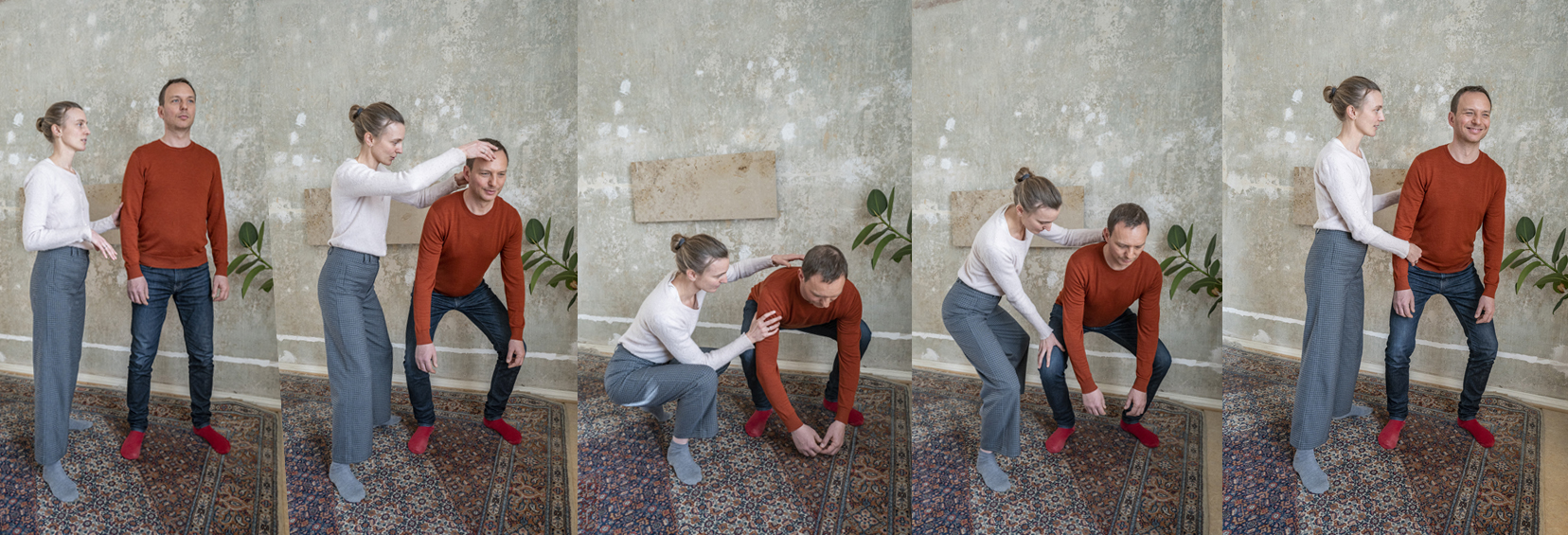
„ We discovered that the therapy is based on exceptionally sophisticated observation, not only by means of vision but also to a surprising extent by using the sense of touch…we already notice, with growing amazement, very striking improvements in such diverse things as high blood pressure, breathing, depth of sleep, overall cheerfulness and mental alertness, resilience against outside pressures, and also in such a refined skill as playing a stringed instrument…“ Nikolaas Tinbergen in his acceptance speech for the Nobel Prize
For whom and for what
The Alexander Technique is not aimed at any particular group of people – it can be used by anyone and everyone!
Many people find the Alexander Technique through certain complaints, and it is helpful and soothing on many levels.
However, the focus is on “experiment” – for the Alexander Technique works investigatively and indirectly. It provides experiential information about how you use/organize yourself and how you can improve this – and thus initiates a whole series of processes that can lead to help with your concrete complaints as well.
Some examples of people’s concerns consulting the Alexander Technique:
Health concerns/health prevention
e.g. for tension in the neck and shoulders, back pain, joint pain/arthritis, headaches, insomnia, depression, burn-out, breathing/voice problems. Alexander Technique is also suitable as a preventative health measure
Studies on the effectiveness for neck pain, back pain and Parkinson’s disease
professional reasons
performances, lectures, stage fright
Alexander Technique helps to make your body and voice resonant and to have a clear relationship to space. Allowing yourself to take up more space in front of an audience and taking breaks turns a performance from a hurdle race into an opportunity to share your own abilities with others – joyful and curious!
Alexander Technique shows how to stay calm and composed on stage or in exam situations. The ability to stay with yourself, to be present and to interrupt oppressive mechanisms helps to regain control and to perform with presence of mind and enjoyment. On the other hand, it becomes easier to accept one’s own anxiety and still remain capable of acting.
musicians, dancers, actors and sportspeople
Alexander Technique helps to perform more complicated movements without becoming too tense. Anticipating particularly challenging passages, we often become more tense than necessary. Alexander Technique helps us to maintain a relaxed attitude so that we can practise and perform with greater ease and coordination. The calmness we achieve creates space for creative processes and solutions, which are often inhibited when we are tense.
voice and breath
At the beginning of his career, when Alexander mainly addressed his work to singers and actors, he was widely known as “The Breathing Man”. He applied his indirect method from the outset: to improve the overall use of the body and the self. As soon as the body is no longer impaired by misdirected tensions, the breath and voice can unfold freely. Tried and tested breathing techniques, e.g. in relation to the vocal organs or the diaphragm, can be explored and executed more precisely with this knowledge so that they can do their job instead of leading to additional tension.
Establishing conscious, present contact with the body provides us with an important guide: our bodies are fine instruments that give precise signals that we have largely forgotten how to perceive. With Alexander Technique, we are able to retune the “radio station” and turn “gray noise” into an undisturbed conversation.
By consciously pausing and focusing in space and upwards, our receptiveness and alertness automatically increase – we are less likely to lapse into brooding or hectic thinking. This helps us to stay in the present moment, to be truly connected with what is there instead of dwelling on our ideas – this is the space for real action and transformation.
Personal development, emotional help
Many insights in this work are non-verbal – via the body. They contribute to a deeper understanding of ourselves and enable us to explore emotional or psychological levels.
Opening our posture, breathing deeply, supportive and appreciative touch offer fundamental emotional help.
Alexander Technique can release a fundamental trust in oneself, one’s own body and one’s own possibilities for regulation. It supports a clear and self-confident contact with oneself and lifts the spirits. It increases our presence of mind so that we can better recognise where and when we are weakening ourselves. With this knowledge, it is easier to open up and make decisions that are in harmony with our well-being. This can set in motion a fundamental and sustainable process that helps us to gradually realise our potential in a productive and appreciative way.
During and after pregnancy, the Alexander Technique offers support in adapting to the new physical situation. In order to deal with the weight of the unborn child in your body as well as with the weight of the baby/ toddler later on, it helps to develop a good sense of your own weight and to learn to shift your balance sensibly instead of reacting with tension.
Alexander Technique helps to find a new balance again and again, to let go of tension in the pelvis, to open the body and to allow breathing to flow. It supports contact with yourself in the whole and the ability to trust the natural processes of pregnancy and birth and let them take their course.
The ability to pause and align yourself, as taught by Alexander Technique, can also help you to avoid stress when breastfeeding and caring for your baby and to find a way of being mindful of your child while still being with yourself.
in old age
In old age, when the body becomes less stable and it seems more difficult to maintain balance, the Alexander Technique provides valuable help in remaining upright and in balance. When the senses begin to fade and usual orientation decreases, Alexander Technique can help us not to fall into anxiety or impatience, but to continue to learn new things, reorient ourselves and gain new stability.
